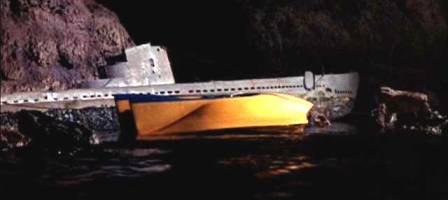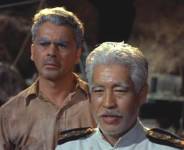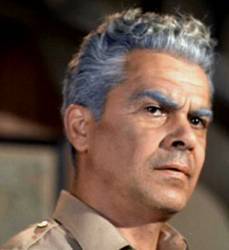
| Voyage to the
Bottom of the Sea |

| And Five Of Us Are Left Airdate: October 3, 1965 |
|
 |
 |
 |
||
Capt. Ryan & Nakamura |
Ryan's son, Frank |
Rescue amid destruction. |
|
And Five Of Us Are Left |
|
Phillip Pine
Says: "It was an extremely good script
and the character of Ryan appealed to me. I liked his
determination to survive and his faith that his government would
one day rescue them. The scenes where his son confronts
him were also well written. I remember Teru Shimada
was having difficulty pronouncing some words in the scenes
where the depth charges are blasting us. Irwin
Allen suddenly came down and he yelled at Teru and
director Harry Harris, threatening to remove Teru from
the scene. I finally had enough and told Mr. Allen off.
I said that if he didn’t leave the set right now, I was
leaving. He left and Teru and Harry thanked me."
|
 |
 Nelson consoles Esaka Nakamura. |
Mark Says: Some TV books have mistakenly described the storyline of this exceptional episode as nothing more than Seaview’s crew battling mad Japanese soldiers still fighting World War II. That couldn’t be more wrong and that is a huge disservice to this segment. It’s typical of the kind of criticism Voyage has endured, even when it got things right. This is Voyage’s best year-two script, an intelligent, thoughtful character study of five survivors of WWII who have had to depend on each other for survival for 28 years. The only Japanese soldier, Esaka, is a gentle, kind-hearted man who has become friends with |
| the Americans who were once his captors. Phillip Pine is the moral Captain Ryan, James Anderson the cynical Tony Wilson and Teru Shimada is Esaka - excellent performances by all. This segment is almost an anthology, since the Seaview crew has little to do with the proceedings, other than to rescue the survivors. The last scene, of Nelson offering hope to Esaka about the future, is one of Voyage’s most satisfying - and human - moments. |
| Mike Says: I have a real (dare I go ahead and say it?) BITCH with the music that all but destroys the effectiveness of this episode. Heavy-handed whining violins tell you when to feel sad or upset for the characters. This episode is saddled with some of the worst of this sort of manipulative film music I've ever heard, and it really ticks me off because the rest of the production is quite good, including the script. And then, during the big climactic action scene . . . no music at all. Whoa is me! What could John Williams or Jerry Goldsmith have done with this episode? BOO on episode composer Lennie Hayton! .Also, I object to the silly beach scene with Crane at the beginning of this outing. It was obviously pasted in to add a sexy dimension to the show, as when Nelson apparently spends the night with his Russian spy friend in the previous episode. These sorts of excursions just feel "off" for this show. Usually snappy director Harry Harris was a bit flat with the direction of this episode. |
|
|
|